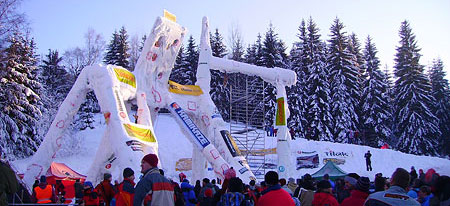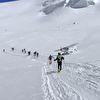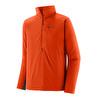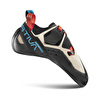Ice climbing World Cup, Spicak, the athletes point of view
On 28/01 at Spicak (Czech Republic) the second stage of the UIIA Ice Climbing World Cup was won by Simon Wandeler and Ines Papertahead of Markus Bendler (2), Harald Berger (3) and Ksenia Sdobnikova (2), Anna Torretta (3).
 UIAA Ice Climbing World Cup, a second stage not without "extra" difficulties, but definitely without the speed event. Last weekend the second stage of the UIAA Ice Climbing World Cup took place in Spicak, the Czech Republic, and was won by Simon Wandeler from Switzerland and Ines Papert from Germany. Wandeler placed first ahead of Markus Bendler and Harald Berger, while Papert beat Ksenia Sdobnikova and Anna Torretta into second and third place respectively. 33 men and 8 women took part in the event which unfortunately was not with controversy regarding the quality of the ice and the actual competition structure, which proved to be well below World Cup standards and the athletes' expectations. Furthermore, the Speed event was cancelled as the wall deemed unsuitable. In part the problems that have arisen in Spicak were foreseeable. On the one hand because ice in itself, a fundamental element for these competitions, is difficult to "work" and "construct" - unless of course people decide to eliminate it completely and compete total dry, i.e. on artificial holds only. On the other hand the immense work (and logistics) needed to create a World Cup structure require immense knowledge and experience which cannot be improvised from day to the next. Looking towards the future, what remains and must continue, is the commitment of all (Federations, organisers and athletes themselves) so that the "machine" i.e. the newly formed (or rather, reborn) world ice climbing circuit can continue to progress and continue to improve, obviously based on past experiences. This is nothing new - this is exactly what has happened in the last twenty years for the "older" circuit of international sport climbing competitions. And it is for this reason that we have decided to publish two texts sent to us from the athletes themselves, in the hope that they can serve as a basis for a constructive dialogue. The first comes from Urs Odermatt, the longest competing athlete in the international circuit (he has participated since the historic competition in Cortina '99), while the second comes from Harald Berger, the current World Champion and provisional leader of the World Cup 2006 together with Ines Papert. point of view URS ODERMATT By minus 17 degrees I arrived in Spicak. Pretty cold. The big place around the ski area had been prepared for the next stage of the Ice climbing World Cup. Around the structure there was a little village with tents: warm up tents for competitors, others for Press and VIPs. It seemed to be well organised. Only the structure was quite small. Steep, but many red lines made most competitors afraid. In the end though the judges were very fair and kind, so almost no one got stopped because of lines – except me. But is it the organisers problem when I step 20cm beyond the line? Maybe no, and from a professional climber we can expect that he can handle this. So the best 8 competitors reached the final. The men's and women's final route was very interesting for the spectators, but maybe sometimes a bit confusing for the athletes. A perfect selection in the women's event proved to be a high class spectacle: Anna Toretta fell 3 moves beneath the top. Xenia Sdobnikova reached the last hold, but couldn’t do the final move. Once again Ines Papert was the only one to climb to the top - a clear result with one top, perfect. Just after that, the Men’s final started, already late, but once again a very spectacular route with a very difficult move on vertical snow. Only Simon Wandeler was able to climb over this move but he then fell, totally pumped, on the last stalactite. The awards ceremony was held even before the next discipline: Speed climbing. Very strange, but an even bigger surprise was that there was no prize money at all. After that it was time for the speed climbing. We were already 3 hours late, but everybody was ready to show how fast it is possible to climb. Once again the only problem was the structure. There was not a special Speed Wall like in Italy or in Switzerland, but all the athletes were still optimistic. They had to be, after travelling 2000 km for this moment. But nothing happened. The proposed route was only steep snow and had nothing to do with ice climbing. The Russian team, the absolute reference point for speed events, made a protest. Many discussions followed. Finally, at 22.30pm the athletes decided not to compete. By the way, there were absolutely no spectators any more, the competition was over. With mixed emotions I drove 800km back, looking forward to the next competition. Should I be angry, because there was no speed? I’m sad and disappointed, of course. But otherwise was there a very good atmosphere with drinks, food, quite a few spectators and good music. I've decided to give them a second chance next year, hopefully with a different structure. Urs Odermatt point of view HARALD BERGER Since finding out that the Ice Climbing World Cup is under the auspice of the UIAA, or rather, the ICCIC, we hoped for more rule conformity, a minimum of ice structure design, a reciprocal exchange of experiences between the various organisers, in short, an improvement and rise in quality of ice climbing competitions. Highly motivated therefore I paid my Alpine Club fee, knowing full well that the money also goes towards the ice climbers’ cause. Unfortunately I had to admit in Spicak that this isn't the case. Since no people with IWC experience had deemed the Spicak structure competition worthy, the structure turned out to be inadequate for a professional world cup. Despite the fact that for days temperatures had dropped to as much as -20°C (ideal to ice an competition structure) the "icing" turned out to be 70% snow. As far back as 6 years ago the IWC organisers had experienced that a snow cannon on its own is not enough to create the ice. The dry tooling sections were played out on 30cm wide boards - this resulted in the artificial holds being zoned off in 30 cm diameter areas, much like the snow moves. Climbing within these zones was definitely impossible, since you had to touch or lean on areas outside of these zones. So the judges decided that we could climb outside of the zones with our knees! Simon Wandeler, the experienced endurance athlete demonstrated the strongest nerves and the highest pain tolerance, but his thin knee is now as thick as that of Hermann Maier. Despite this he clearly climbed higher than everyone else and justly received the "golden" award. Superfit Markus Bendler placed second, while I received bronze, despite the fact that Samuel, Evgeny and I all slipped through the same snow hole... Unfortunately many strong climbers such as Gerd, George, Toni, fell victim to unclear line rulings. One confusing judge statement was "one hit outside the zone is allowed"?! Definitely unfunny was the fact that a few athletes only just missed groundfalls, but there swings into the pillar were all the more efficient (bruises, here we come!) Things weren't much different in the women's comp, a few bruises, hooks that ripped out, many hours in isolation and thank God no groundfalls. The result: Ines - Xenia – Anna. I really had to laugh though when I watched the Speed event from the warmth of the "Stodola" restaurant: the athletes had to race up the inclined snow ramp to the top of the tower! "Please don't fall off" was the name of the game and an acrobatic touchdown was programmed well in advance. Given the situation, the world cup field shrunk to just 3 competitors. The question now is what my Russian climbing colleagues think of all this? They prepare themselves specifically for the Difficulty and Speed events and invest at least 200-300⬠for the Visa, registration fee, journey, hotel etc. for each competition (for many a Russian climber a small fortune)! These costs are often financed through the prize money, which this time round didn't exist in neither the Difficulty nor Speed. All that is left to mention is the fact that the Czech organisers tried as hard as possible to make the best of the situation, making up for the many problems with good mood and enthusiasm. But the main question for me now is a different one: what is the role of the UIAA/ICCIC? And is antidoping a decisive element to assure the quality of an ice climbing competition? Unfortunately I can't help from making the following comparison: as FIS organisers I decide to hold a stage of the ski world cup on the German Ost Friesen islands in the North Sea, make sure that antidoping controls are carried out, but forget that to run the competition mountains are needed! Hurray, Olympia here we come! Harald Berger UIAA ICE CLIMBING WORLD CUP 2006 2nd stage Spicak, CZ - 27-28/01/2006 Results women 1 Ines Papert DE 2 Ksenia Sdobnikova RUS 3 Anna Torretta IT 4 Petra Müller CH 5 Jitka Mázlová CZ 6 Franziska Dönhuber DE 7 Julia Oleynikova RUS 8 Jaroslava Melounová CZ Results men 1 Simon Wandeler CH 2 Markus Bendler AUT 3 Harald Berger AUT 4 Eevgen Kryvosheytsev UKR 5 Samuel Anthamatten CH 6 Israel Blanco RodrÃguez ESP 7 Jack Müller CH 8 Gerd Dönhuber DE 9 Jan Doudlebsky CZ 10 Jirà Pelikán CZ photo: the ice structure in Spicak (ph Anna Torretta)
| ||||||||||
Latest news
Expo / News
Expo / Products
Hiking boots ideal for day walks of medium difficulty on varied terrain.
An ultralight two-person tent for trekking and biking.
Crash pad for bouldering and climbing
A full-Zip Hoody for cool, high-output days when you need a compressible, stretchy, featherlight insulated layer.
The most versatile No-Edge® climbing shoe of the whole La Sportiva range.
The Guida HDry gloves are the evolution of the Guida model, enhanced with HDry technology, making them ideal for all weather conditions.



 Copia link
Copia link
























